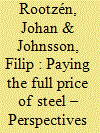|
|
|
Sort Order |
|
|
|
Items / Page
|
|
|
|
|
|
|
| Srl | Item |
| 1 |
ID:
119815


|
|
|
|
|
| Publication |
2013.
|
| Summary/Abstract |
This paper provides an analysis of the current energy usage (net energy and final energy by fuels) and associated carbon dioxide (CO2) emissions of the Swedish residential building stock, which includes single-family dwellings and multi-family dwellings. Twelve energy saving measures (ESMs) are assessed using a bottom-up modeling methodology, in which the Swedish residential stock is represented by a sample of 1400 buildings (based on data from the year 2005). Application of the ESMs studied gives a maximum technical reduction potential in energy demand of 53%, corresponding to a 63% reduction in CO2 emissions. Although application of the investigated ESMs would reduce CO2 emissions, the measures that reduce electricity consumption for lighting and appliances (LA) will increase CO2 emissions, since the saved electricity production is less CO2-intensive than the fuel mix used for the increased space heating required to make up for the loss in indirect heating obtained from LA.
|
|
|
|
|
|
|
|
|
|
|
|
|
|
|
|
| 2 |
ID:
125431


|
|
|
|
|
| Publication |
2013.
|
| Summary/Abstract |
This study assesses the prospects for presently available abatement technologies to achieve significant reductions in CO2 emissions from large stationary sources of CO2 in the EU up to year 2050. The study covers power generation, petroleum refining, iron and steel, and cement production. By simulating capital stock turnover, scenarios that assume future developments in the technology stock, energy intensities, fuel and production mixes, and the resulting CO2 emissions were generated for each sector. The results confirm that the EU goal for reductions in Greenhouse Gas Emission in the sectors covered by the EU Emission Trading System, i.e., 21% reduction by 2020 as compared to the levels in 2005, is attainable with the abatement measures that are already available. However, despite the optimism regarding the potential for, and implementation of, available abatement strategies within current production processes, our results indicate that the power and industrial sectors will fail to comply with more stringent reduction targets in both the medium term (2030) and long term (2050). Deliberate exclusion from the analysis of mitigation technologies that are still in the early phases of development (e.g., CO2 capture and storage) provides an indirect measure of the requirements for novel low-carbon technologies and production processes.
|
|
|
|
|
|
|
|
|
|
|
|
|
|
|
|
| 3 |
ID:
125549


|
|
|
|
|
| Publication |
2013.
|
| Summary/Abstract |
This article investigates possible evolution pathways for the transport sector during the 21st century, globally and in Europe, under a climate change control scenario. We attempt to shed light on the question how the transport sector should best be decarbonized. We perform our study with the global bottom-up energy systems model TIAM-ECN, a version of the TIAM model that is broadly used for the purpose of developing energy technology and climate policy scenarios, which we adapted for analyzing in particular the transport sector. Given the global aggregated perspective of TIAM-ECN, that in its current version yields at every point in time a single CO2 price for different forms of energy use across geographic regions and economic sectors, it generates a decarbonization process that for the transport sector occurs later in time than for the power sector. This merely reflects that emission reductions are generally cheaper for electricity production than for transportation, and that it is thus cost-minimizing to spend limited financial resources available for CO2 emissions abatement in the power sector first. In our scenarios the use of hydrogen in internal combustion engines and fuel cells, rather than electricity as energy carrier and batteries to store it, gradually becomes the dominant transport technology. This outcome is in agreement with some recent publications but is at loggerheads with the current popularity of the electric car. Based on sensitivity analysis we conclude that even if the establishment of a hydrogen infrastructure proves about an order of magnitude more costly than modeled in our base case, electricity based transportation only broadly emerges if simultaneously also the costs of electric cars go down by at least 40% with respect to our reference costs. One of the explanations for why the electric car is today, by e.g. entrepreneurs, often considered the supposed winner amongst multiple future transportation options is that the decision horizon of many analysts is no more than a few decades, instead of a full century. Electric cars fit better the current infrastructure than hydrogen fueled vehicles, so that from a short time perspective (covering the next decade or two) investments are not optimally spent by establishing an extensive hydrogen distribution network. Hence the path-dependency created by the present existence of a vast power transmission and distribution network can make electricity the most efficient choice for transportation, but only if the time frame considered is short. Electric transportation generally proves the more expensive alternative in our long-term perspective, except when electric car costs are assumed to drop substantially.
|
|
|
|
|
|
|
|
|
|
|
|
|
|
|
|
| 4 |
ID:
098564


|
|
|
|
|
| Publication |
2010.
|
| Summary/Abstract |
This study investigates consequences of integrating plug-in hybrid electric vehicles (PHEVs) in a wind-thermal power system supplied by one quarter of wind power and three quarters of thermal generation. Four different PHEV integration strategies, with different impacts on the total electric load profile, have been investigated. The study shows that PHEVs can reduce the CO2-emissions from the power system if actively integrated, whereas a passive approach to PHEV integration (i.e. letting people charge the car at will) is likely to result in an increase in emissions compared to a power system without PHEV load. The reduction in emissions under active PHEV integration strategies is due to a reduction in emissions related to thermal plant start-ups and part load operation. Emissions of the power sector are reduced with up to 4.7% compared to a system without PHEVs, according to the simulations. Allocating this emission reduction to the PHEV electricity consumption only, and assuming that the vehicles in electric mode is about 3 times as energy efficient as standard gasoline operation, total emissions from PHEVs would be less than half the emissions of a standard car, when running in electric mode.
|
|
|
|
|
|
|
|
|
|
|
|
|
|
|
|
| 5 |
ID:
149897


|
|
|
|
|
| Summary/Abstract |
This study examines the impacts felt downstream of carbon pricing and investments made in CO2 abatement within the steel industry. Using the supply of steel to a passenger car as a case study, the effects of a steel price increase on cost structures and price at each step of the supply chain were assessed. Since the prices of emission allowances under the European Union Emissions Trading System fall well below those required to unlock investments in low-CO2 production processes in the integrated steelmaking industry this paper seeks to pave the way for a discussion on complementary policy options. The results of the analysis suggest that passing on the compliance costs of the steel industry would have only marginal impacts on costs and prices for the end-use sectors (e.g., on the production cost or selling price of the passenger car). Under the assumptions made herein, at a carbon price of 100 €/tCO2, the retail price of a mid-sized European passenger car would have to be increased by approximately 100–125 €/car (<0.5%) to cover the projected increases in steel production costs.
|
|
|
|
|
|
|
|
|
|
|
|
|
|
|
|
| 6 |
ID:
121354


|
|
|
|
|
| Publication |
2013.
|
| Summary/Abstract |
This work explores public opinions regarding climate change and mitigation options and examines how psychological factors, such as attitudes, norms, and willingness to pay, determine self-reported energy-efficient behaviour. The aim is to create knowledge for the design and implementation of policy measures. The results of an opinion poll conducted in 2005 and 2010 are compared. The number of respondents favouring new technologies as a way to reduce emissions was substantially lower in 2010 than in 2005, whereas there was an increase in the number of people who acknowledged that lifestyle changes are necessary to counteract climate changes. This indicates an increased awareness among the public of the need for lifestyle changes, which could facilitate implementation of policies promoting environmental behaviour. Renewable energy and energy saving measures were ranked as the top two measures for mitigating climate change in both polls. In determining which energy behaviours of the public are determined by psychological factors, an analysis of the 2010 survey revealed that respondents with pro-environmental attitudes towards global warming favour significantly increased use of renewable energy technologies and greater engagement in energy-efficient behaviours.
|
|
|
|
|
|
|
|
|
|
|
|
|
|
|
|
|
|
|
|
|